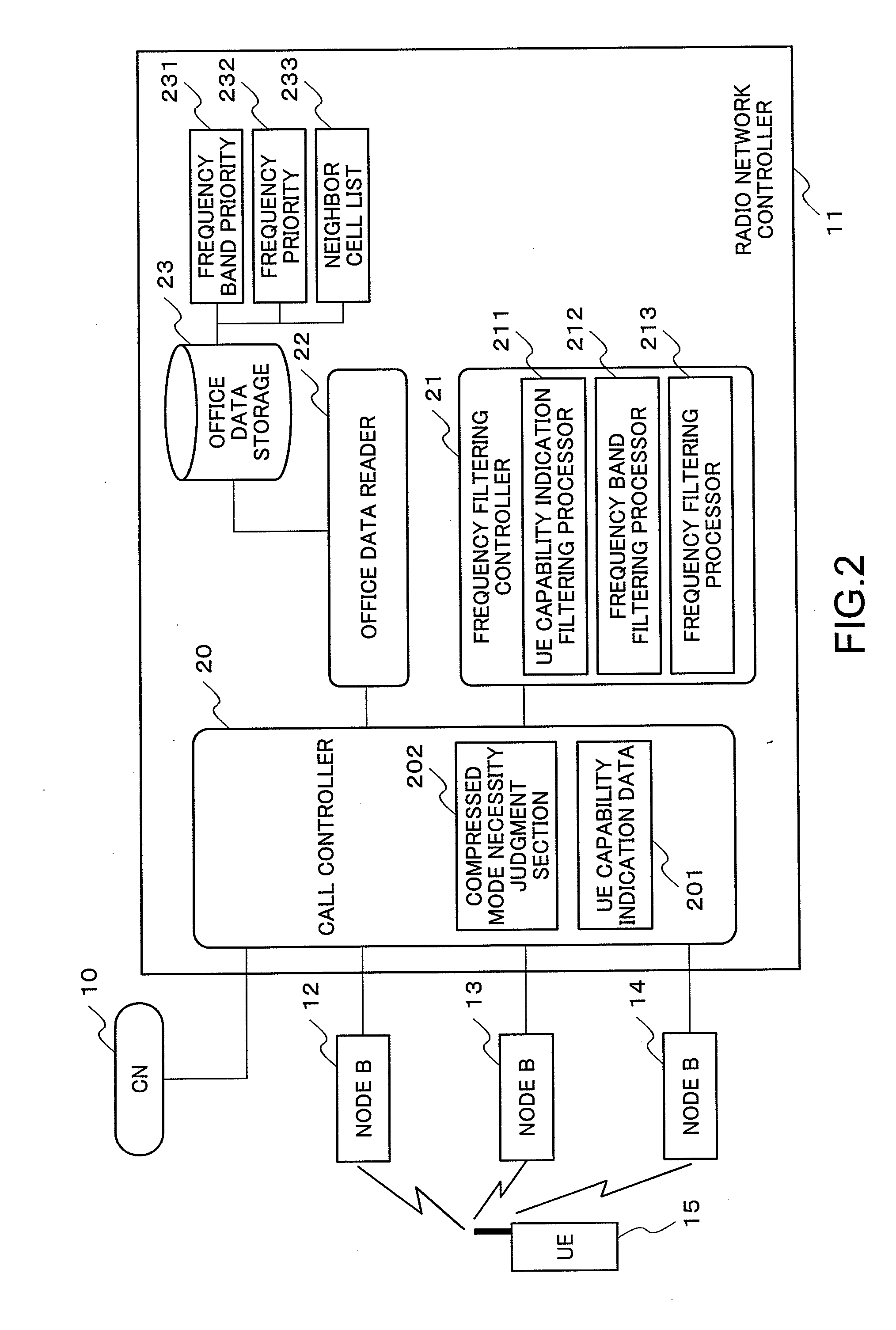Radio network controller, a mobile communication system, and a neighbor cell list filtering method
a radio network controller and neighbor cell technology, applied in the field of radio network controllers, a mobile communication system, and a neighbor cell list filtering method, can solve the problems of inflexible control of the mobile communication system itself, decreased channel number, and consequently decreased radio capacity, so as to reduce the frequency of interference
- Summary
- Abstract
- Description
- Claims
- Application Information
AI Technical Summary
Benefits of technology
Problems solved by technology
Method used
Image
Examples
first embodiment
[0091]An inter-frequency hard handover using frequency bands and frequencies according to priority intended by the network operator, who manages the network environment in which a plurality of frequencies and a plurality of frequency bands exist, will be explained as a According to this embodiment, the network operator can perform setting so as to give priority to a microcell over a macrocell.
[0092]FIG. 5 shows a table showing a specific example of a neighbor cell list corresponding to the Node-B of the cell in which the UE 15 is locating and is stored in the office data provided in the RNC 11. With referring to FIG. 5, there are cells ID 1 to 30 as neighboring cells of the Node-B, and frequency bands 1, 3, and 6 are mixedly used. Three frequencies (UARFCN=9612, 9613, and 9614) are used in a frequency band 1. One frequency (UARFCN=8562) is used in a frequency band 3. One frequency (UARFCN=4162) is used in a frequency band 6.
[0093]On the other hand, it is assumed that the UE 15 is u...
second embodiment
[0105]As a second embodiment, the inter-frequency hard handover under the network environment managed by a plurality of network operators will be explained. In this network, the frequency band used by each network operator is different from each other, and the RNC 11 is commonly used by all network operators.
[0106]FIG. 13 is a drawing showing allocation of cells managed by a plurality of network operators in the network. With referring to FIG. 13, the network operator A (PLMN-ID: Public Land Mobile Network Identity=A) uses the frequency band 3, the network operator B (PLMN-ID=B) uses the frequency band 1, and the network operator C (PLMN-ID=C) uses the frequency band 6. A “black circle” in drawing shows an original location of the UE 15 before moving, and a “white circle” shows a later location of the UE 15 after having moved. It is assumed that the UE-a 15 is a subscriber of the network operator A, and that the UE-b 15 is a subscriber of the network operator B. It is assumed that b...
third embodiment
[0120]Furthermore, as a third embodiment, an embodiment of controlling the use priority of frequencies according to load condition of each cell using either traffic or radio loads, and executing the inter-frequency hard handover will be explained. Here, the case that priority is controlled according to a situation of radio loads will be explained. This embodiment can aim at distributing a load in each cell by making the UE handover from the heavy load cell to the light load cell. In this explanation, traffic means, for example, traffic density, a channel usage rate, or the like, and a radio load means, for example, interference quantity. In addition, it may be possible to control priority for distributing a load using these traffic and radio loads in complex.
[0121]FIG. 19 is a drawing showing cell allocation in a third embodiment which controls the use priority of frequencies according to a situation of a radio load of each cell, and executes the inter-frequency hard handover. With ...
PUM
 Login to View More
Login to View More Abstract
Description
Claims
Application Information
 Login to View More
Login to View More - R&D
- Intellectual Property
- Life Sciences
- Materials
- Tech Scout
- Unparalleled Data Quality
- Higher Quality Content
- 60% Fewer Hallucinations
Browse by: Latest US Patents, China's latest patents, Technical Efficacy Thesaurus, Application Domain, Technology Topic, Popular Technical Reports.
© 2025 PatSnap. All rights reserved.Legal|Privacy policy|Modern Slavery Act Transparency Statement|Sitemap|About US| Contact US: help@patsnap.com



